Is DnD Beyond Worth The Money?
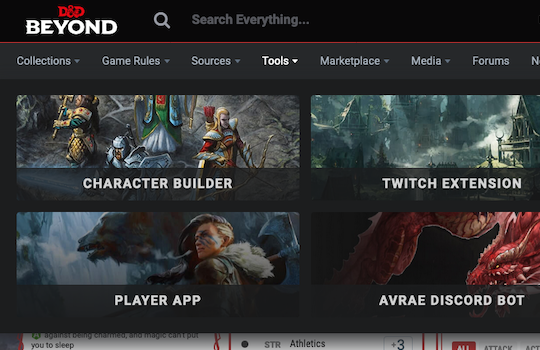
Originally Published Dec. 2020. Republished April, 2021 to include the new Player app, the Player Bundle, and to correct some inaccuracies about the Master Tier.
D&D Beyond is the premier online Dungeons and Dragons site. Note that while the domain is dndbeyond.com, the site’s name is D&D Beyond. We’ll be honest: We left the title “DnD Beyond” because that’s what people search for, and we were hoping you’d come read our article.
D&D Beyond is not what one might expect – a marketing vehicle for showcasing content. There are definitely elements of that. But its real aim is to help D&D players get more from the game. To that end it provides a plethora of tools and resources. Players can access the rules, create character sheets, horde virtual dice, and find out what’s new. Dungeon Masters can access the sourcebooks, organize campaigns, create encounters, and create custom items. And there is a lively community in forums and chat channels.
Some of these things are free. Many are not. And with bundles and annual subscriptions, the options can be confusing. So what’s worth it, and what is not? In this article, we try to clarify how things are structured, and what you get when you pay for certain features. We offer our opinion on what’s worth it and what’s not.
The Overview
This review is a little more in depth than the usual. This is mainly because there is so much to cover. So we’ll break things down into a few categories.
We will stay focused on the web site, though it is good to know that there are two very good apps that tie into this content. There is a D&D Beyond Player App for character sheets, and there is a compendium app (called D&D Beyond) that gives you access to sources that you have purchased.
The Free Tier
Without a DnD Beyond account, you can learn plenty about the game, including the basic rules. But when you create an account, you don’t need to pay a dime to get access to some fabulous features.
Character Sheets
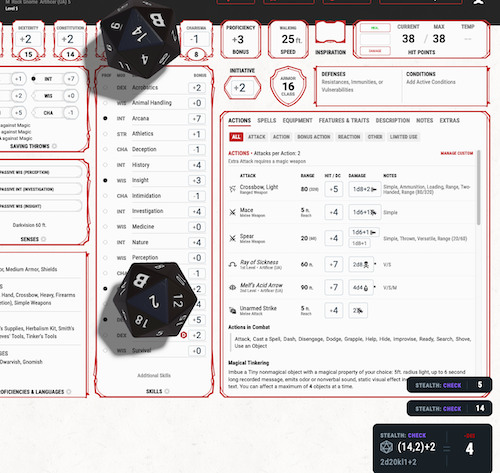
By far the most important feature you get with a free D&D Beyond account is the Character Builder. On the free tier, you can build up to six characters. The Character Builder provides you with four excellent features:
- You can create new characters. The experience is great for both new and experienced players.
- If you use a tablet, phone, or laptop when you play, you can use the online character sheet.
- It helps you track hit points, spell slots, qi points, and so on
- The text of spells and abilities are a click away. Click a spell name and read what it does and how it works.
- The short and long rest features help you reset to correct levels
- When it’s time to level up, the tool walks you through the upgrade
- And if you prefer the pen-and-pencil experience when you are playing, you can easily print out a player sheet that matches the one in the Player’s Handbook.
On top of that, D&D Beyond recently added a really cool feature: When you’re using your character sheet online, you can click on a number and have it roll dice for you. Strength check? Click your strength modifier and watch the dice roll. It will then show you the dice roll combined with your modifier for a total. Attack role? Click your weapon of choice and it will roll, add abilities, and do the math for you.
Along the side of the character sheet, there’s also a menu of dice. That way, when your DM says “Hey, roll a d100 for me,” you can just click the dice in the menu and watch them roll. In a moment, we’ll talk more about the digital dice. But for now we’ll turn back to other free D&D Beyond features.
Access to Basic Content (and an Option to Purchase Other Content)
With a free-tier account, you can access the basic rules, the forums, descriptions of standard races and classes, and select other content.
If it is your first time playing Dungeons and Dragons, there is definitely enough in the free content to get you playing without having to buy the Player’s Handbook.
Now here’s where things get a little confusing: With your free account, you can purchase source books and adventures. That is, if you want to buy a digital copy of the Player’s Handbook, you must first create a free-tier account. Then you can purchase the handbook and access it through your free account. Later on, we’ll cover both purchasing content and what higher tiered accounts do.
Tools for Dungeon Masters
The free tier also adds several great tools for DMs.
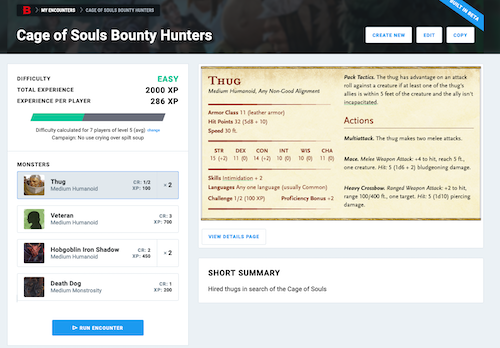
- The Campaign Manager lets you create campaigns and then invite players to join. Here at L&L, we use this for all of our campaigns–even the ones we are doing on Roll20.
- The Homebrew Creations tools help you create your own things:
- Create custom magical items cross-linked to the spells they perform
- Build your own weapons, giving them cool names, damage bonuses, and even magical properties
- Create your own monsters, either by cloning and modifying existing ones, or by starting from scratch
- The Encounter Builder lets you add a bunch of monsters to a named encounter. It also compares your encounter to your party’s abilities, letting you know how difficult the encounter will be (and how many XP it will generate). If you drop a couple bugbears and a half-dozen goblins into an encounter, it will warn you that this is too difficult for your level one party… or way to easy for your level twelve party.
- The Combat Tracker helps you keep track of turn order and monster stats during combat. You can either run an encounter that you created with the Encounter Builder, or you can set up combat on the fly. We like the fact that it can auto-roll initiative for your monsters while your players are rolling their own initiative.
At present, the free tier lets you save only eight Encounter Builder encounters. We don’t know of any free tier limits on the number of Campaign or Homebrew Creations you can create.
Use the Apps
With a free-tier account, you can also use the D&D Beyond compendium app to access your source books. You can also use the new D&D Beyond Player App, which gives you a native experience for using your character sheet on your phone or tablet.
Update: As of April, 2021, the two apps have been combined into one.

Both of these apps require you to log into your D&D Beyond account. On the L&L team, many of us use the Player app. And our DM, Matt, uses the compendium app on a daily basis.
So that’s it for the free tier. The casual D&D player can probably get along just fine with the free tier and nothing else. For those that have a physical copy of the Player’s Handbook, even the more engaged D&D player may never need more than the free tier options. But let’s take a look at the additional content and what you can get.
Digital Dice
Digital dice are a new feature on D&D Beyond. When you play using the online character sheet we discussed above, you can click on various places on your character sheet and watch the dice roll. For example, you can do a stealth check by clicking on the “stealth” proficiency. By default, D&D Beyond will project three-dimensional dice onto the screen. They will roll around for a bit before coming to a halt, where you can see what you’ve rolled.
When you create a free tier account, you will have access to a couple sets of default dice. One is black with white numbers. The other is black with red numbers. Neither are terribly exciting.
If you want to get fancy, though, you can buy other digital dice.
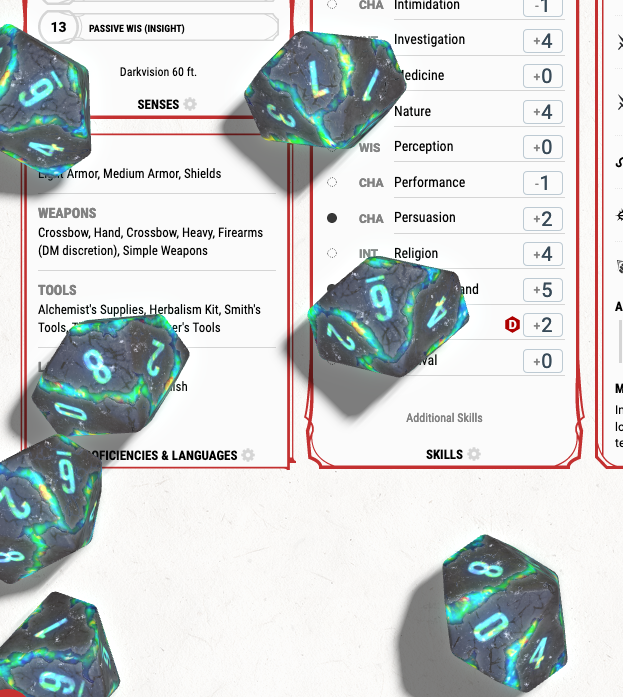
Some come bundled with other things. The pictured set here came as part of a promotional package for Tasha’s Cauldron of Everything.
Standalone sets can be found on the digital dice page of the store. They vary in price. At the time of this writing, the sets for sale are between $8.00 and $15.00. The more expensive ones typically have special visual effects. For example, they present fancy animated sequences when you roll a natural 20 on a d20.
In our opinion digital dice are not particularly compelling. They’re purely cosmetic. But if you’re interested in a fancier rolling experience, keep an eye out. Typically when new books come out, a set of themed dice are also released.
Sources and Bundles
Digital dice are not the only things for sale in the D&D Beyond store. You can also purchase digital copies of official D&D source books. You can get every book in the official line of hardback books. And occasionally you can get some that are not published in print.
The books are broken up into two categories: Sourcebooks and adventures.
The sourcebooks include the Player’s Handbook, the Dungeon Master’s Guide, the Monster Manual, and a whole bunch of others. These books add rules, items, classes, settings, and monsters to the game. They also may add new lore and background material.
Adventures provide out-of-the-box storylines that DMs can run for their campaigns. For example, the popular Dragon of Icespire Peak adventure provides a local setting, an overarching plot, and a series of quests that you can play with your party.
Most of the digital sources cost the same as their printed counterparts. We have also not seen any sources where the digital and print copies were bundled. If you want a physical copy and a digital copy, you typically have to buy each separately.
Why Digital Sources Are Worth It
In our view, some of the digital sourcebooks are almost must-haves. In fact, we would recommend digital copies over physical copies. There are several reasons why a player is better off with the digital version:
- In a word, search. It is very convenient to be able to search for that feat, that spell, or that niggly rule.
- When you purchase a sourcebook that has classes, items, feats, spells, races, etc., those become available in your D&D Beyond character sheet. For example, when you purchase the Player’s Handbook, you can access to the additional ranger and sorcerer subclasses (among other things)
- Paired with the mobile app, these are a lot easier to carry along with you than the physical copies
- When errata (error fixes) are published, they automatically appear in your digital version
- With the digital art, you can zoom in and out. This is very helpful with maps.
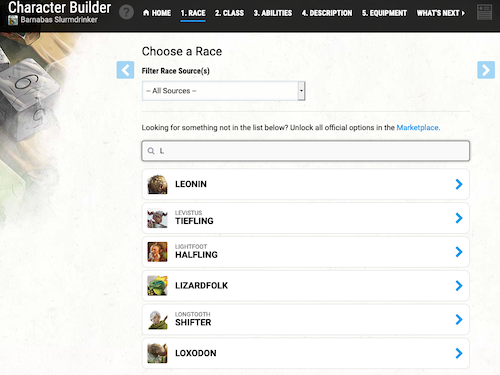
And if you are a DM, they are very much more worth it for a few additional reasons.
- New monsters and creatures from a digital book are added to your Encounter Builder.
- Running adventures is really a lot easier when you can quickly find things in your sources.
- If you use a virtual tabletop, you can use some of these digital assets (like maps and art) to display to your players.
- And if you have the Master Tier subscription (which we’ll get back to in a bit), important parts of these digital sources can be shared with your players.
At the time of this writing, there is also one set of digital maps available for purchase. None of us at L&L has purchased this, and likely will not. We’ve got an article in the works about Roll 20, and in that article we’ll talk about digital maps.
Which Digital Sources Should You Get?
We think the Player’s Handbook is good for all players and DMs.
DMs also want the Monster Manual and the Dungeon Master’s Guide.
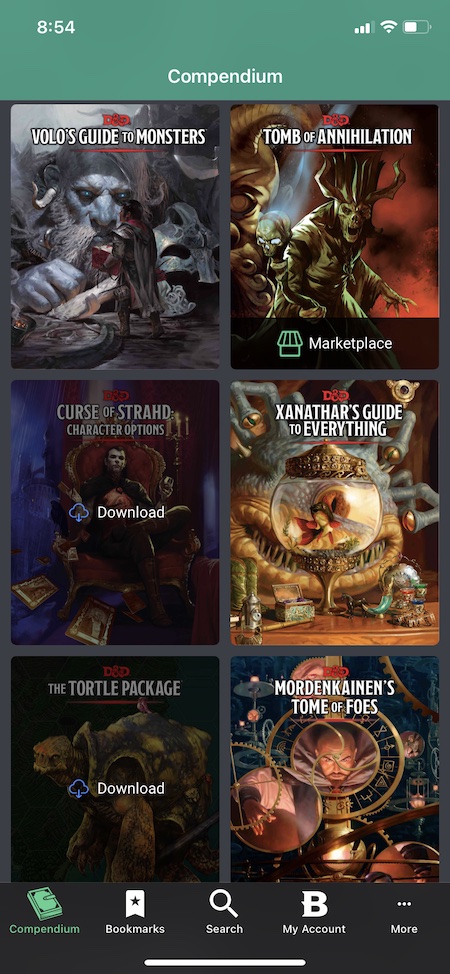
Above that, Xanathar’s Guide to Everything and Tasha’s Cauldron of Everything are good for players and DMs who want to expand their horizons. While Mordenkainen’s Tome of Foes and Volo’s Guide to Monsters are good fodder for DMs who want lots of new enemies along with some history and lore.
Many others are setting-specific. DMs who want to play in those settings will like the digital copies of those books.
There is only one book that we do not recommend buying. That is The Wayfinder’s Guide to Eberron. The reason is that the material there is included (in expanded form) in the book Eberron: Rising from the Last War, which is in every way superior. The Wayfarer’s Guide was published a few years earlier, and is still full of useful information. But it’s less than half the size of Rising from the Last War.
But before purchasing anything, hang on one moment. You might consider grabbing a bundle instead of buying individual. Or you might consider trying to get your DM to buy a higher-tier subscription.
Bundles
There are three rather pricy bundles that you can always purchase:
- The Sourcebook Bundle: All of the sourcebooks available when you purchase
- The Adventure Bundle: All of the adventures available when you purchase
- The Legendary Bundle: Every source available at the time you purchase
Update: In early 2021, a new Players Bundle has appeared! For under $100, players can get access to the Player’s Handbook, Sword Coast Adventurer’s Guide, Xanathar’s Guide to Everything, and Tasha’s Cauldron of Everything.
Each of these is a few hundred dollars. (The price goes up with each new published book.) But the bundles are typically 10% or more off of the combined price of the books. So if you’re planning on buying lots of books anyway, this might be a good deal for you. Take note that these bundles only include the books published at the time you purchase. As new books are added, bundle holders will get a discount on the new material.
If you already bought a few digital books on D&D Beyond, the bundle price you see on D&D Beyond will reflect that. The bundle price will deduct the price of the book you already purchased.
So are the bundles worth it?
Our opinion goes like this:
- If you are simply a DnD player, no. These bundles are not worth it unless you just really want to read everything.
- Updated: The new player-focused bundle is definitely worth it if you want to deep dive into the DnD multiverse.
- If you are a DM…
- And you run only a one or a few games, the Sourcebook Bundle is worth it
- And you are the sort of fanatical DM who runs lots of games in lots of settings and wants a ton of variety, the Legendary Bundle could be worth it
In our opinion, it just doesn’t make much sense to buy the Adventure Bundle.
The main L&L DM, Matt, has the Sourcebook Bundle and is quite happy with his purchase. But he isn’t interested in the Legendary bundle because he doesn’t often run his adventures out of the official books.
Subscriptions and Tiers
To this point, we have only talked about the free tier of membership to D&D Beyond. You can purchase digital dice and sourcebooks and adventures when you are a free tier member. But there are two additional tiers of membership. In this section, we’ll talk about those two.
Hero Tier
With the free tier, you are limited in the number of characters you can create (6), and the number of encounters you can build (8).
The Hero tier is for people who think those limits are too low. In fact, with Hero tier, both of those limits are completely removed. That is, you can make as many characters and encounters as you want.
Some of us may have a bad habit of building a character during particularly boring meetings. We like the hero tier.
Another cool advantage of the Hero tier is that you get early access to new features at D&D Beyond. Paid tiers got access to the Digital Dice, the Encounter Builder, and the Combat Tracker when they were still in early (alpha) development.
We might have gotten a free set of dice, too. Just sayin'.
Hero tier is a nice level for players who don’t like limits and who want early access to (probably unstable, but still cool) new features.
Master
For DMs, the Hero tier is nice. But in our opinion, if you can afford it, springing for Master tier is a wise move. It has all of the features of the Hero tier, and one additional feature that is BIG.
When our DM upgraded to Master tier, he did so for one reason: By upgrading to Master, he could share much of his purchased content with the players in his campaign. When he got Mythic Odysseys of Theros, we could suddenly start creating Leonins. When he got Tasha’s Cauldron, we could all choose a bunch of new feats and spells.
This is because the Master tier has a content sharing feature that allows DMs to choose some or all source material to make available to players in a campaign. Even at the Master tier, sharing is limited to only five campaigns of no more than 12 players each. This is no doubt to discourage those who would abuse the system. In practice, though, it’s hard to imagine any one DM actually running more than five concurrent games. (There’s probably a superhuman DM somewhere, though.)
Before you get too excited about the Master tier and content sharing, we should make one thing clear.
Content sharing does not mean that all of the players in your campaign suddenly get access to all of the sources you have.
They get access to relevant material from these sources.
Correction: Whether things have changed, or whether we were not smart enough to figure this out before, it is definitely when a DM shares the content, players can access all of the content in the shared sourcebook. This has been a HUGE boon. We left the original text here (in strikethrough) so you can see just how wrong we were.
Classes, subclasses, races, items, weapons, feats, and spells all suddenly become available in your players' Character Builder and search.
But they can’t necessarily read the text of the book.
For example, if you have the Master tier and purchase one of the Eberron source books, your players will be able to create
Warforged heros with the Artificer class from a Dragonmarked house.
But they won’t be able to read the background on the history of the Mourning.
In our view, this is both a blessing and a curse. As a DM, you definitely want (and need) your players to have access to “the stuff.” But you may not want them reading through the adventure you are about to run. That would spoil the fun.
But it does mean that even if you have a Master tier subscription and the Player’s Handbook,
you still might encourage your players to buy their own (physical or digital) copy of the handbook
so that they can read the material.
Summary
We’ve looked at a lot of options in this article. D&D Beyond has a ton of useful stuff. And a surprising amount of it is absolutely free. But of the stuff that is for sale, what is worth spending money on?
Here’s a roundup of our recommendations:
- First-time players may be happy with just the free tier and nothing else.
- More frequent players will likely want at least the Player’s Handbook. And we highly recommend the D&D Beyond digital version.
- Players who are big fans of D&D will love the added features of the Hero tier
- Your inner dice horder might spring for a set or two of digital dice if you use the Players App or the online character sheet when you play.
In total, you’re likely to spend between $50 and $120.
When it comes to DMs, if you can afford it we think it makes sense to go big on D&D Beyond. We think the best combination is the Master tier subscription with the Sourcebook Bundle. And when you’re ready to run an adventure or two, grab a digital copy. This combo allows you to share content with your players, which decreases the cost for them. And it allows you a little more control over what features they can use.
The Master/Bundle combo with a few adventures will likely run you in the $300 to $400 range. If that’s too much, we recommend getting the Master tier and then just grabbing a few of the choice sourcebooks we recommended above.